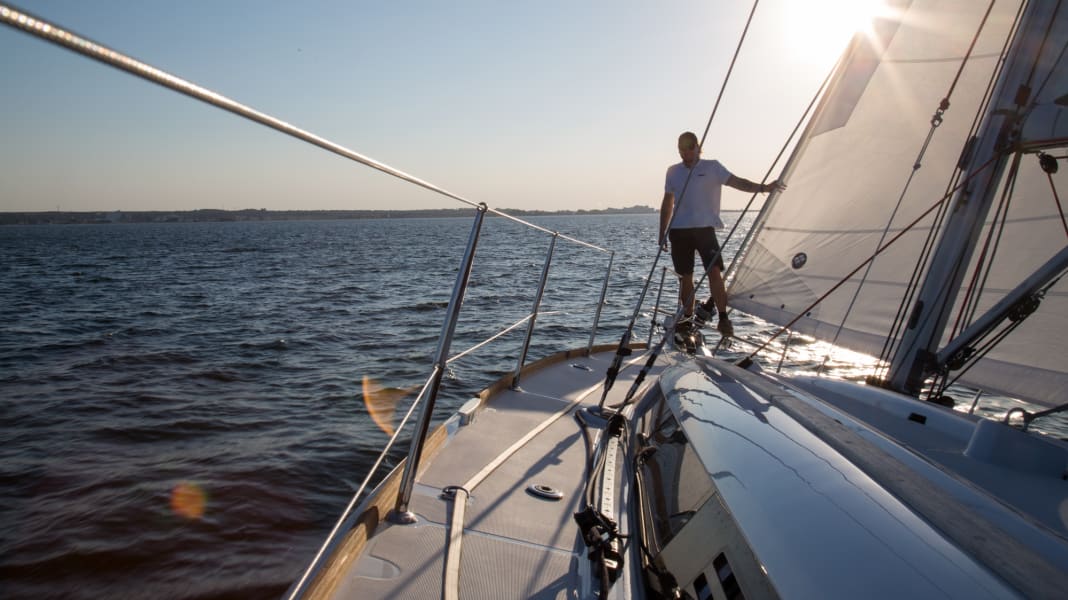
- Charter error 1: chartering a boat without experience
- Charter error 2: too large ship selected
- Charter error 3: chose the cheapest provider
- Charter error 4: no co-skipper or no crew with practical experience on board
- Charter error 5: Defects not written in the minutes
- Charter error 6: no crew briefing
- Charter error 7: not informed about the peculiarities of the area
- Charter error 8: slavishly following the sailing plan and not having a plan B
- Charter error 9: Ignoring the needs of fellow sailors
- Charter error 10: wanting to do everything alone
- Charter error 11: Manoeuvre insufficiently discussed
- Charter error 12: only fast and sloppy anchoring
- Charter error 13: Hatches not closed when sailing
- Charter error 14: sailed with the dinghy in tow
- Charter error 15: Bathing platform warped (when mooring)
- Charter error 16: Faecal tank blocked
- Charter error 17: Muring line not sufficiently tensioned
- Charter error 18: approaching shoals too closely
- Charter error 19: Furling sail incorrectly operated
- Charter error 20: not sufficiently informed in advance
This article is part of a charter special. The contents:
Charter error 1: chartering a boat without experience
Although relatively few customers only charter with a "Sportbootführerschein See", even recent graduates of the "Sportküstenschifferschein" sometimes simply lack practical experience as a skipper. Sure, there's always a first time. But anyone who has never done a harbour manoeuvre with a keel yacht should think about attending a skipper training course before their first charter trip. This doesn't have to last a week and be expensive - even a compact seminar over a long weekend can be very useful if the instructor is good. Such courses are often available for just a few hundred euros, depending on the location.
Charter error 2: too large ship selected
You've just got your licence, asked around in your circle of friends, and a whole bunch of friends already want to join you on a cruise. So you need at least a four-cabin boat with as many bathrooms as possible. But then you're quickly well over 45 feet in length. When things get tight in the harbours of many Mediterranean areas in the high season, you have to be able to manoeuvre such a yacht in narrow pit lanes. Simply pushing the boat away or holding it off if a manoeuvre doesn't quite work will no longer work. So it's better to start one size smaller and stay under 40 feet.

Charter error 3: chose the cheapest provider
Of course, nobody wants to spend more money on their charter than necessary. But beware: if you are on the hunt for the cheapest offer, you should bear in mind that there are companies out there that may appear to be extremely cheap, but do not always maintain their boats ideally. The risk of getting a boat in poor condition that causes problems during the trip is higher with low-cost providers. It is better to tell the charter agency that you are a beginner and are looking for a company that maintains its boats really well. The bottom line is that the boat may cost two, three or even four hundred euros more. But the higher price usually pays off in the form of a carefree sailing holiday.
Charter error 4: no co-skipper or no crew with practical experience on board
A classic situation: one person has a licence, all the other sailors on board are occasional sailors who only go on a boat with a friend on the lake in the neighbourhood. As a beginner, it makes sense to look for at least one experienced co-sailor who is willing to support the skipper. For example, by discussing tricky mooring or casting off manoeuvres with him beforehand. It also makes sense not to take over the boat alone at the beginning, as two pairs of eyes can see more. In addition, one person does not have to memorise all the details, such as where things are stowed, where the safety devices are and much more. This protects the skipper from being overwhelmed, especially on the first few trips that he is responsible for.
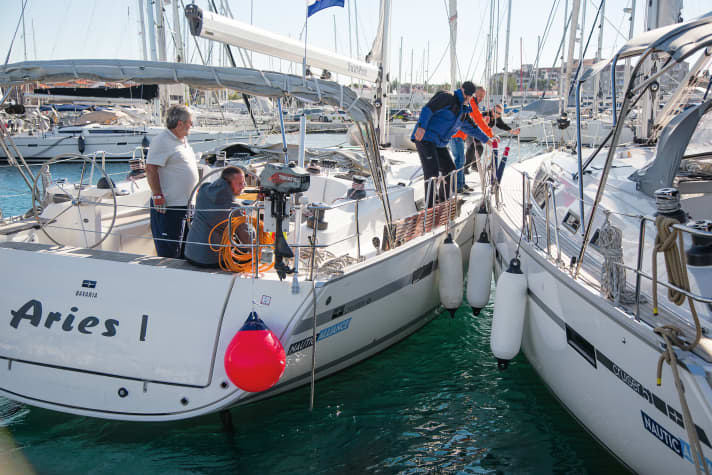
Charter error 5: Defects not written in the minutes
At the start of the trip, everyone is excited and wants to set off straight away or explore the town. Meanwhile, the skipper takes over the boat, perhaps having to wait a long time for the base employee. He then finally draws up the handover report. A few things are missing on board or don't work one hundred per cent, but the skipper doesn't consider them absolutely necessary. Or there is visual damage to the boat or equipment and the base manager waves it away, saying that it is known and comes from the previous crew. Anyone who does not record this in the log will have a difficult time later when they return the boat. If another base employee then carries out the handover and complains about the damage, it can lead to unpleasant disputes and become expensive. Therefore: make a note of the existing equipment, check the hull and deck and write down any defects and damage in the log. Have the latter countersigned by the base employee and take a copy with you.
Charter error 6: no crew briefing
Damage or problems on board are often caused by incorrect operation by the crew. Therefore, explain everything, such as the function of the toilet and faeces tank. Also which sea valves should be closed and when. Show how the anchor windlass and bow thruster work and where their extra fuses are located. Explain the special features of the reef and warn that an electric winch can quickly tear a sail if operated carelessly. Make it clear that a refrigerator running in sailing mode drains the batteries. In short, a check-in for the crew is a must. The trick is to briefly explain everything that is necessary in a way that the crew understands.
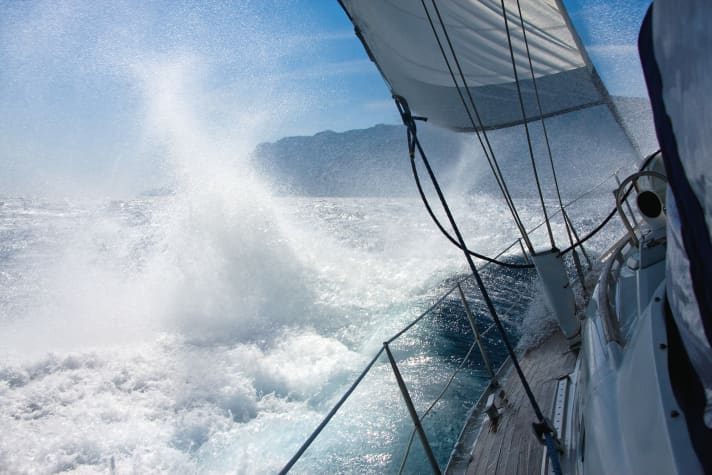
Charter error 7: not informed about the peculiarities of the area
The dream of a cosy summer cruise in the Mediterranean is appealing, but it is tempting not to familiarise yourself with the local conditions well enough before booking or setting off. In some areas, there are sometimes treacherous winds even in midsummer, such as the Mistral on the Côte d'Azur, the Meltemi in the Aegean or the Bora in Croatia. The harbours are sometimes different from what you learnt during your training. Suddenly you have to familiarise yourself with mooring lines or how to use the bow anchor in Greek harbours. What's more, the marinas in the Balearic Islands or in parts of Croatia or Italy can quickly fill up during the summer season. If you're not there by early afternoon, you'll be left out in the cold. If you book early or late in the year, you have to be prepared for periods of bad weather. Information on this can be found in area guides or on area websites on the Internet (e.g. www.yacht.de/chartern). It is best not to wait until you start your trip to read them.
Charter error 8: slavishly following the sailing plan and not having a plan B
A lot of planning is good, but you also have to remain flexible. If it becomes apparent during the trip that the intended route cannot be completed because the weather is too bad or there is no wind, the skipper must at least have a rough idea of what the alternatives could be. Sailing into bad weather with inexperienced sailors or planning the trip in such a way that you may have to tack many miles into the wind towards the end and risk a late return is not a good idea. However, this presupposes that you keep an eye on the weather on site every day! Think about possible alternative routes in advance or during the trip. This also applies to arriving in harbours or bays late in the day during the peak season. If they are overcrowded, it is often reassuring to have a plan B up your sleeve that only requires you to cover a few extra miles.
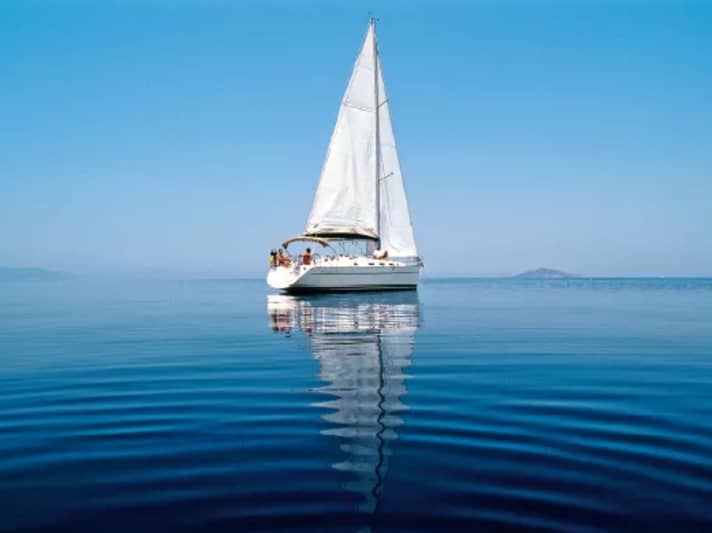
Charter error 9: Ignoring the needs of fellow sailors
One person wants a lazy beach holiday, another wants to do a lot of sporty sailing. The next wants to go to a restaurant in the evening, the other prefers to cook on board. Some want to have as little to do with the cruise planning and manoeuvres as possible, others want to participate as much as possible; they are frustrated if the skipper excludes them from his considerations and decisions. A sure instinct is therefore required. Find out who expects what before the trip. And ask from time to time whether things are going well from the point of view of your fellow sailors. Sometimes anger builds up, which then comes to a head towards the end of the first week and creates a bad atmosphere on board. As we all know, a boat is like a social magnifying glass; your own quirks and those of others carry more weight than at home because of the close-knit atmosphere.
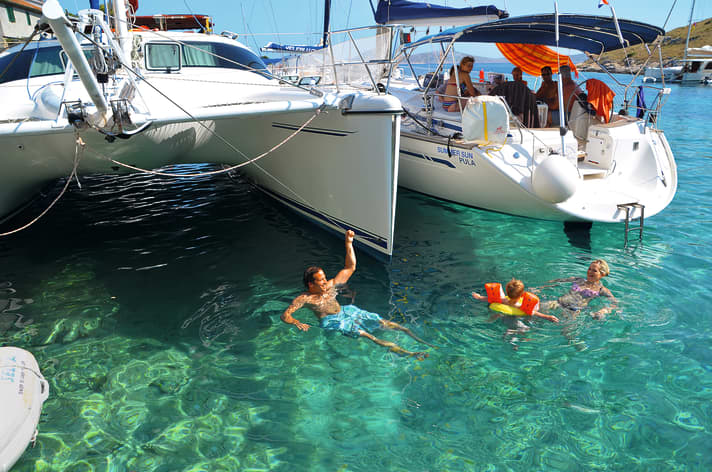
Charter error 10: wanting to do everything alone
Beginners in particular overextend themselves on their first trips by taking on an unnecessarily large number of tasks on board: Seacocks closed while sailing? Switch on the radio? Hatches tight? Water tanks still well filled? Holding tanks drained? Is there still enough petrol in the outboard tank? There are so many small tasks on board that are sometimes too much, especially for beginners. So delegate smaller jobs, especially if your fellow sailors are also relatively inexperienced. Everyone closes the hatches in their cabin, one person checks all the valves when leaving, another checks the water tank level every day. In this way, everyone feels like a useful member on board. A daily checklist can be helpful for first-time skippers: Weather forecast, tanks, battery voltage, logbook entry and more. It takes time for this to become second nature.
Charter error 11: Manoeuvre insufficiently discussed
Most mistakes happen when mooring or casting off, but also when manoeuvring under sail, because not everyone in the crew is aware of their role. It starts quite simply with the skipper saying which manoeuvre is to be performed, such as mooring with the stern and mooring lines. The individual positions, such as handing over the stern lines or taking up the mooring lines, must be filled. Crucial for manoeuvres with crosswinds: Which are the windward lines? Make it clear that these are more important and perhaps fill the positions with the more experienced people. Are gloves and boat hooks ready for the mooring line? Important for the skipper: How will the wind shift the boat when docking? Does it make sense to sail backwards into the lane because there is no room to tack?
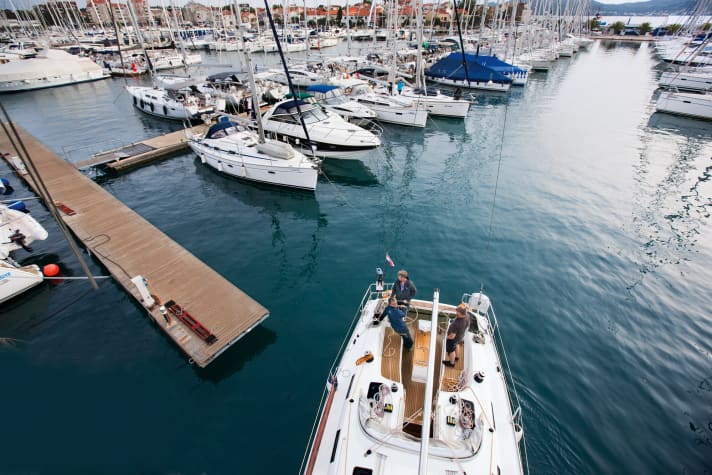
Charter error 12: only fast and sloppy anchoring
It's just too tempting: chugging into the bay in calm conditions, looking for a spot, dropping anchor, putting in 20 or 30 metres of chain - and that's it! The crew is then in a hurry to get into the water. Once everyone has disembarked, three things tend to happen: 1. other yachts come into the bay and moor directly around their own ship. 2. the crew like it so much that they decide to stay overnight. 3. towards evening, everyone wants to go to the restaurant on the beach. The result is often that you haven't put in enough chain because you "only wanted to stay for a short time" or didn't pull in the anchor properly. But correcting and redoing the manoeuvre is no longer possible because there are too many other yachts in the bay. If you simply go to bed in the evening, you may be in for a rude awakening at night: The wind shifts or picks up and the anchor slips. So just get into the habit of anchoring as if you want to stay. In other words, align the boat with the wind, put in enough chain and drive in the iron properly.

Charter error 13: Hatches not closed when sailing
A sheet often gets caught under an open hatch when tacking, for example, and if the line is pulled, it can tear out. And if a crew member steps on the slightly open hatch and a sheet lies underneath, the frame can bend due to the point load. Due to their design, hatches on some yachts also protrude well beyond the support of the frame. If crew members step on the corners, they can break off. This can even happen when the hatch is closed. Point this problem out to the crew at the start of the trip.
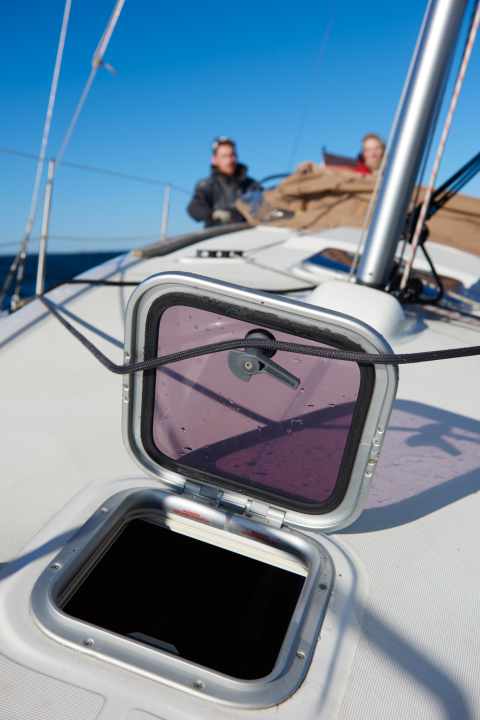
Charter error 14: sailed with the dinghy in tow
The dinghy was in use during a swimming stop, now it's just a matter of getting to the next bay or harbour. Nobody wants to heave the dinghy back on deck, stow the engine and rudder and tie it down, so the dinghy is sailed under tow. This is not a major problem for dinghies with a solid GRP floor and bolted towing eye. However, cheaper dinghies with a soft bottom and only vulcanised towing eyes often behave differently - the eyes tear out if too much load is placed on them. And this is quickly the case with a bit of wind and waves. Especially as you are rarely the first crew to put such a strain on the dinghy. The eyelets are often already weakened by UV light. Better to take the dinghy on board when sailing.
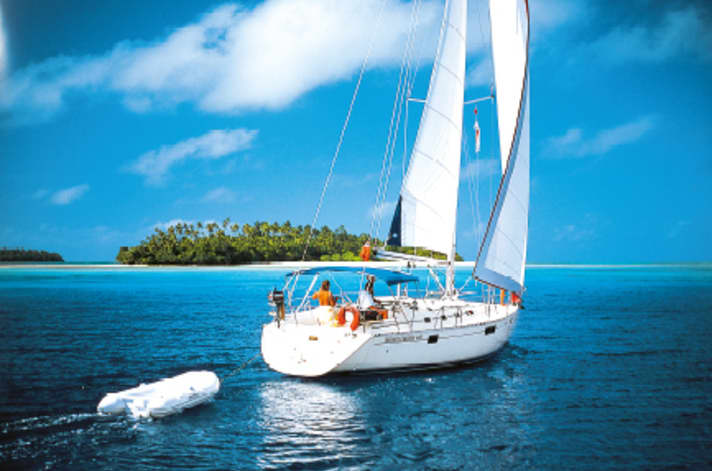
Charter error 15: Bathing platform warped (when mooring)
The lowerable bathing platform is now standard almost everywhere. It is often folded down even when the yacht is moored at the jetty or pier in the harbour. However, it should be closed when the yacht is moored, however tempting it may be to use it as a jumping-off aid onto the jetty. This is because a lowered bathing platform is fragile and cannot be easily stowed away. If the skipper touches the pier while manoeuvring with it, the result is usually major GRP damage or, even worse, bent hinges. Unfortunately, these are an expensive weak point of many such constructions.
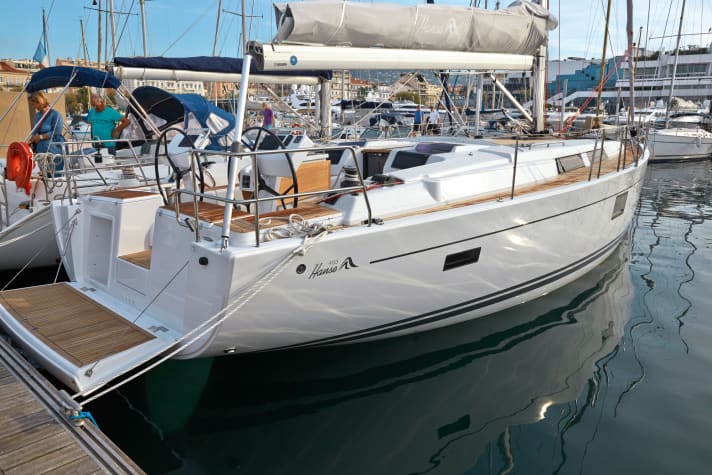
Charter error 16: Faecal tank blocked
That can spoil any trip: The waste water no longer drains, the toilet is blocked. Frequent cause: A crew member - or one of the previous crew - has flushed paper, dental floss or sanitary products down the toilet. The result: the tank is blocked. Second possible cause: The tank was opened too rarely and flushed too little. If there are a lot of solids in the tank and the crew only flushes with a few pump strokes and then leaves everything to rot for days, the pipes can also become blocked. If you have to return to base, you often have to pay a fee of 100 to 300 euros. Therefore, anything that doesn't go through your body doesn't go into the toilet, especially toilet paper. This is disposed of separately in bin liners. Waste bins are available in every bathroom! And always flush well - 15 to 20 pump strokes after use are not too much. The pipes to the tank are often over two metres long due to fittings and swan necks. Furthermore, open the tank frequently - far out at sea or for suction in the harbour.
Charter error 17: Muring line not sufficiently tensioned
Moored in light winds, the co-sailors take over the mooring and stern lines, the skipper drives the boat to the pier at a safe distance to climb over. Then he has the foreship man haul through the mooring line and tie it up. Tighten the stern lines. Done. Just not! If an onshore wind comes up or a passing larger vessel causes swell, there is still so much slack in the mooring ring that the stern can hit the pier. Therefore: Once all the lines are clear for mooring, move the boat forward by just under one and a half to two metres. Allow the mooring ring to be set and then bring it under tension with the engine astern until the distance to the pier is right. Then the crew can relax in the restaurant in case the wind picks up.

Charter error 18: approaching shoals too closely
One of the pitfalls of modern navigation is that many sailors think that digital nautical charts in the plotter are as accurate as the sat nav in their car. When sailing around a shoal, they may make the mistake of zooming in closer and closer and then steering the boat around at a distance that looks right on the screen - and then it crashes. There can be two reasons for this: Often, the boat was zoomed in so close that the distance in the plotter, which looked generous, only corresponded to a distance of 50 to 100 metres in reality; however, stones and rocks are often not marked so precisely in nautical charts. Another reason: when surveying shallow water areas of less than around five metres, the hydrographic services do not record every rock, as they put their expensive equipment at risk in such waters. This means that not every rock is recorded on the maps! An indication such as "large rocks" should therefore ring alarm bells and you should be careful to keep enough distance.

Charter error 19: Furling sail incorrectly operated
The genoa is often furled with a strong beat in the wind - and with the winch. If it is furled too tightly, the furling line may have reached the end. The winch is used to pull it out of the plastic stop in the reefing drum. It is better to drop to a low course to recover the genoa. Then there is so little load on the sheet and therefore on the furling line that you can easily furl the sail by hand. If there is too much resistance, check whether the line is at the end at the front! There are other problems with the main: If it has flapped a lot when furling or was too loose, creases will form in the furling mast. When unfurling, they can jam in the groove on the back of the mast. If you now pull with the winch, everything jams tighter and tighter. Either nothing works or the crew tears the foot with the winch. Therefore: head upwind. The downhaul should not be set for reefing. Fasten the outhaul in a controlled manner and at the same time furl slowly so that the sail does not beat too much but is also not too loose. This avoids creases.
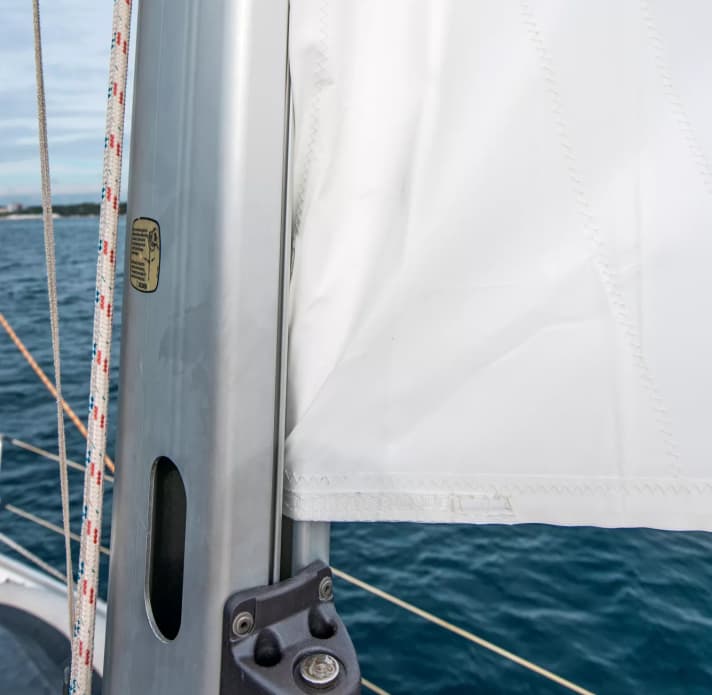
Charter error 20: not sufficiently informed in advance
If you're unsure about seamanship, have weaknesses in harbour manoeuvres or want to know how reefing, anchoring, sparking and other things work, you'll find detailed tutorials on the YACHT TV YouTube channel! They are free and provide a solid foundation.

